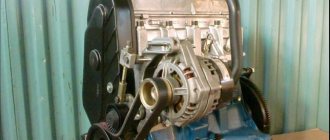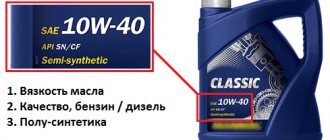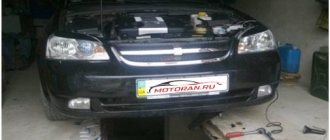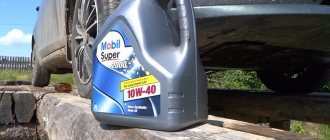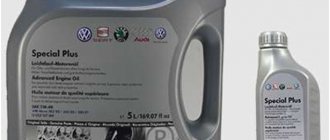A modern, lightweight SUV is a “people’s” car of optimal quality and low cost. Widespread use in the primary and secondary markets provokes the emergence of questions such as what kind of oil to pour into a Chevrolet Niva engine to achieve maximum service life without loss of performance characteristics. There are a large number of answers on the forums, but they are not always accurate or correct. Only the vehicle manufacturer can provide the most accurate information.
What kind of oil is poured at the factory?
Contrary to the prevailing opinion that assembly lines use “what was at hand,” the manufacturer uses lubricants that fully correspond to the design of the motor. The main lubricant is usually a fluid with GM Dexos 2 approval, which is required due to joint production with the American Chevrolet brand. At the same time, the viscosity used is 5W30 - the standard corresponds to the climatic conditions of central Russia and the CIS countries.
Also, official dealers are required to use such lubricants during routine vehicle maintenance. But after the warranty expires, some motorists prefer to fill in analogues due to their availability or personal preference.
Castrol Magnatic
Castrol Magnatic 5W-40 oil is suitable for Chevrolet Niva. It is also advisable to use an option with additives that contain molecules that attract oil to parts. In other words, this allows the oil to remain on the walls of the parts for a long time, even several days after the machine has been stopped. And then the liquid drains into the crankcase. In addition, additives ensure the safety of parts and protect them from premature wear. The oil has a transparent shade and high consistency.
What oil is better to fill in a Chevrolet Niva after warranty service?
The selection of an analogue of a factory liquid is carried out according to several points. At the same time, to achieve the maximum effect, all parameters must be observed.
The basis
When asked what kind of engine oil to fill in a Chevrolet Niva, you should choose the right base - the lubricant base. In 2022, there are three types of liquids.
- Mineral is the most common and budget version of lubricants. Lubricants are produced by simple distillation of sour petroleum followed by the addition of a group of additive components. The advantage of lubricants is their minimal price. The disadvantages include insufficient efficiency when the load increases and a low crystallization threshold.
- Semi-synthetics are a more modern category of liquids. Oils are obtained primarily by combining artificial and natural components, which ensures sufficient performance, durability, and engine protection from scale and burning. Also classified as semi-synthetics are hydrocracking mixtures, although their properties are as close as possible to artificial formulas. When asked what kind of oil to fill in a Chevrolet Niva with high mileage, you can safely buy similar products.
- Synthetics are the most advanced development designed for modern cars with minimal mileage. Lubricants are obtained by splitting molecules of natural gas or rapeseed oil, for the subsequent isolation and structuring of chains of complex hydrocarbons. The result is a complete absence of foreign matter that could harm the engine or the environment. Additionally, the mixture may contain some polyalphoolefins or esters, which increases its efficiency and service life.
If the car is purchased new, the manufacturer recommends using synthetics. Artificial products increase the stability of the engine and extend its uninterrupted operation time. After 150,000 - 170,000 kilometers, you should change the base to a semi-synthetic one. Typically, such lubricants are a little thicker, which compensates for the wear of the piston group, increases compression in the cylinders and stabilizes the behavior of the internal combustion engine.
Mineral water is not used directly in the car - it can only be filled in in emergency situations, when there is no other way to replenish the fluid supply in the crankcase compartment.
Tolerances
The AvtoVAZ company sets requirements for motor oils no lower than API SL/CF, which will fully satisfy the needs of a 1.7 liter gasoline engine. The use of higher class compounds is also allowed. Filling with low-grade lubricants is prohibited.
Viscosity
The situation is similar with the viscosity of motor oil for the Chevrolet Niva. The standard 1.7 liter naturally aspirated petrol is not a complex or hypersensitive unit. The engine can use fluids that correspond to the climatic conditions of the vehicle. For example, for the middle zone of the Russian Federation it is optimal to use 5W30-10W40. For the south, 0W30 will be the norm, and in the north, 0W20 tolerance is relevant.
Therefore, it is better to select the oil viscosity for a Chevrolet Niva based on the standard temperature tolerances of the SAE specification.
Oil selection table by season (winter, summer)
| Year | Viscosity SAE all season from +25 to -25 °C | winter from -35 to 0 °C | summer from 0 to +35 °C |
| 5W-30 5W-40 | 20W-40 20W-30 25W-30 |
| 5W-30 5W-40 | 20W-40 20W-30 25W-30 |
| 5W-20 5W-30 5W-40 | 20W-40 20W-30 25W-30 25W-40 |
| 5W-20 5W-30 5W-40 | 20W-40 20W-30 25W-30 25W-40 |
How often to change
The standard service interval for a car engine is 15,000 kilometers. The length is set by the manufacturer based on the operation of the machine under moderate loads, filling with high-quality fuel and the oil itself.
In practice, not a single lubricant can withstand the stated time. The presence of a large number of negative factors forces users to perform maintenance already at 6,500 km, reeled off by the speedometer. This is due to the use of gasoline of questionable quality, increased dust conditions and critical overloads when driving. In some cases, replacement is carried out already at 5000 km.
You should also take into account the characteristic features of the car; the manufacturer recommends carrying out the first maintenance at a mileage of 2500 kilometers, after the process of running in all components and mechanisms. After the start of operation, the blocks require grinding in; the process is accompanied by the appearance of metal dust and shavings, which sharply reduces the performance of lubricants and their normal operating time.
What is recommended for use
The correct selection of engine oil is based primarily on determining its operating conditions, both climatic and power influences on the car engine. Based on these principles of approach to the requirements for lubricating fluids, the Chevrolet Niva car engine will work better on oils:
- from SHELL - Helix Plus, Helix Plus Extra, Ultra. The use of these oils allows to reduce friction of the contacting surfaces of the engine. This leads to economical operation, lower fuel consumption and increased vehicle power;
Shell synthetic motor oil for high performance engines
Synthetic engine oil ensures perfect engine operation
Mobil 1 engine oil - and your engine runs flawlessly at any temperature
Easy-to-flow synthetic oil provides extended service life of the Chevrolet Niva engine between oil change intervals.
Motor oil from the largest manufacturer with reduced phosphorus, sulfated ash and sulfur content
Synthetic all season motor oil
Universal synthetic motor oil with added additives allows you to easily start the engine both at + 35°C and at -35°C. Carefully cares for the internal parts of the engine
How to change oil in a Chevrolet Niva
Self-service of a car does not require the driver to have serious knowledge of mechanics or the presence of a specific tool - 90% of motorists have all the necessary keys.
The maintenance procedure is as follows.
- It is necessary to purchase the required amount of lubricant and filter in advance. You will also need to stock up on rubber gloves, eye protection and clean rags.
- Prepare a container for draining the waste with a capacity of at least 4 liters. You can use a cut eggplant from under water.
- Warm up the car to operating temperature - this is necessary to dilute the oil inside the crankcase compartment and facilitate its subsequent draining.
- Drive the car onto an overpass, inspection pit or lift. Some drivers simply put the vehicle on a jack and place a few stumps under the bottom as insurance.
- Open the top cover of the cylinder head casing - it is also the filler plug.
- Unscrew the drain plug, first placing an empty container under it.
- Wait until liquid stops draining from the engine (if metal dust is detected in the waste, it is recommended to contact a specialist) and screw the drain plug into place.
- Remove the oil filter (you can pierce the housing with a screwdriver and use it as a lever).
- After this, install a new filter element, after pouring a little fresh lubricant into it.
- Pour the full amount of fluid through the top cover of the cylinder head.
- Tighten the top plug and operate the machine as normal.
When performing all work, extreme caution must be observed - when warming up, the oil heats up to high temperatures and can cause serious burns if it comes into contact with the skin.
Also, when switching from one brand of lubricant to another, it is recommended to use special flushing compounds. Flushes completely remove waste from the engine and serve as the basis for a fresh portion of oil.
Luxe Hit and Luxe Best
These oils belong to the Delfin Group products and are designed to protect the engine during vehicle operation. They have a synthetic base, save fuel and increase engine stability due to the molybdenum contained in the composition. In the case of a car with a fairly high mileage, these lubricants may be a suitable option.
Thanks to its synthetic base, Luxe Hit is suitable for both cars and trucks with different types of engines: gasoline and diesel, conventional and turbo.
You can safely fill the Niva Chevrolet engine with a set of Lux oils, such as:
What kind of oil to pour into a Chevrolet Niva box
The next common question is the phrase, what kind of oil to pour into a Chevrolet Niva transmission. Initially, the car is equipped with only one type of transmission unit - manual transmission and transfer case. For mechanics, the manufacturer recommends using API GL-4 type mixtures. Version 5 is not used in the block due to the presence of brass synchronizers. More effective lubricants, on the contrary, can damage non-ferrous metals, which will lead to the need for expensive module repairs.
API GL-5 class formulas can be used for the transfer section and bridges. There are no moving parts that could be damaged by active cleaning additives.
Lukoil Lux
The leading place among domestic manufacturers is occupied by Lukoil Lux, an oil with a recommended viscosity class of 10W-30. There are synthetic and semi-synthetic Lukoil oils on sale that are resistant to certain temperatures. It is also necessary to pay attention to the viscosity value. In any case, Lukoil Lux is ideal for the Chevrolet Niva.
Lukoil's Russian products have received positive reviews from owners of Porsche, Renault and Volkswagen cars. Therefore, there is no doubt about the high quality of Lukoil oils. This lubricant maintains its properties during sudden temperature changes and helps break down dirt deposits inside engine components. Another interesting feature is that an engine with such lubrication produces less noise and vibration.
The disadvantages of the product include the need to change the oil every 10 thousand km.
Russian Lux lubricant is produced by Delfin Industry. It uses a so-called molybdenum additive, which provides 3% fuel economy per 100 kilometers. At the same time, by reducing the friction of the couplings, it was possible to increase the service life. In addition, other lubricants from this company are also suitable for the Chevrolet Niva, for example, Lux Best, Lux Hit and Lux Gold.
How often to change
The transmission units of the vehicle a priori experience less thermal stress than the power plant. Due to the absence of critical overheating, the working mixture burns out less and lasts many times longer.
The manufacturer recommends servicing every 35,000-40,000 kilometers, depending on the intensity of use and applied loads. Motorists change lubricants already when they reach 25,000-30,000 kilometers covered by the speedometer.
Lukoil Lux 10W-40
The product is produced by the Russian company LUKOIL and is known not only in the domestic market, but also abroad.
The fluid in question is semi-synthetic. Lukoil Lux 10W-40 can be used at any time of the year and in any conditions. Ideal for gasoline and diesel engines of modern cars, both domestic and foreign.
The benefits of this oil include the following:
- retains its working qualities for a long time;
- remains stable even with sudden fluctuations in ambient temperature;
- has low viscosity, which makes it easier to start the engine in winter;
- has high lubricating properties, allowing you to reliably protect the vehicle’s power plant from wear;
- counteracts corrosion processes;
- allows you to keep engine parts properly clean;
How to change the oil in a Chevrolet Niva box
The operating principle and replacement algorithm are similar to servicing a vehicle’s power plant.
- Drive the car 10-15 km to warm up the lubricant inside the transmission units. This significantly speeds up the drainage of fluid from the crankcase compartment.
- Drive the car onto a viewing hole or lift.
- Prepare empty containers for processing in advance.
- Unscrew the filler plug and drain screw. The top opens to facilitate liquid drainage.
- Wait until the remaining lubricant is completely out of the mechanism.
- Close the bottom plug.
- Use a special syringe or oiler to fill the new lubricant through a special hole.
- Screw on the cover and operate the vehicle as normal.
It is noteworthy that the required volume of oil can be calculated from the filler neck. The normal level is located at the lower edge of the filler neck (on box models where the funnel is located on the side of the body). In other words, pour until it starts to flow out. In this case, the machine must be installed strictly horizontally.
Rosneft Premium
This oil is a fully synthetic high performance product. Contains a synthetic base stock and the latest functional additive package.
Possessing excellent viscosity-temperature characteristics, Rosneft Premium can be used in any climatic conditions.
- provide the engine with the highest level of protection during operation;
- prevention of all types of negative deposits on the surface of parts;
- implementation of easy start-up of the power unit in winter;
- ensuring savings due to low volatility.
Analogues used
In 2022, there is an abundant selection of lubricants of various brands and modifications on the market. However, most drivers prefer lubricants:
- Mobil super 3000;
- TOTAL ineofist;
- LUKOIL Genesis;
- Shell Helix Ultra;
- Castrol Magnatek;
- LIQUI MOLI MOLYGEN;
- VALVOLINE Synpover.
Note! The lubricants listed above are selected among the most popular options and are not mandatory for use. Each user can independently choose a lubricant that is suitable for him.
Shell Helix Ultra
This lubricant is based on synthetic base oils and a high-quality additive package. Thanks to them, Helix Ultra is significantly superior to semi-synthetic materials, not to mention mineral ones. In addition, Shell products have excellent cleaning and antioxidant properties.
The features of this product include the following:
- saves fuel due to low viscosity and low friction coefficient ;
- has better protection against corrosion and premature wear of all elements, including piston group parts;
- to start without much effort ;
- used in engines running on any type of fuel.
Characteristics of motor oils
When choosing an oil, you need to understand that there are not only characteristics declared by the manufacturer, but also those that can only be learned from third-party sources.
Viscosity
The determining parameter that is used during selection is viscosity.
The first digit indicates the cold class of the product. The higher the value, the higher the startup temperature. For example, oils with the 5W index are recommended for use at winter temperatures of at least 25 degrees, while 10W oils are only suitable for climates with a minimum temperature of -20 degrees.
The second digit after the “W” index is an indicator of the hot class. Naturally, at high temperatures the oil should be more viscous. This means that the hot class value should be higher.
Coking ability
When the engine operates, deposits in the form of resins and carbon deposits form in the lubricant. Their quantity is determined by such a parameter as coking ability. Unfortunately, it is impossible to independently establish compliance with standards.
Ash content
This characteristic shows how large the proportion of additives in the oil is that form ash deposits during combustion. The ash content of the lubricant is indicated in Latin letters. Oils with high ash content are marked with the index “A”, with medium and low ash content – “C”.
Cleaning properties
Any motor oil not only reduces friction, but also must “wash” the engine from the inside. The cleaning properties of oils can only be determined during bench tests, so when selecting, you have to rely solely on the authority of the manufacturer.
Watch this video on YouTube
Replacement frequency
The service book states that the oil in the transfer case, gearbox and axles should be changed at the first, fourth and eighth maintenance. This corresponds to mileage of 2000, 45,000 and 105,000 km. After this, the transmission is changed every 45,000 km.
Oil service life depends on operating conditions. If the machine is driven a lot off-road or used in a climate with large temperature changes, the lubricant should be changed more often.
The frequency of replacement is not related to seasonality. The transmission does not need to be changed on the eve of summer or winter.
"Dolphin Industry"
Car owners highlight the products of this company (or rather, the compositions “Lux Hit” and “Lux Best”), since only modern technologies and the latest developments are used in the production process of lubricating fluids.
Also interesting: Choosing mud tires for a Chevrolet Niva
If, when deciding which oil to pour into the Chevrolet Niva engine, you chose this particular composition, then you should pay attention to the fact that it contains molybdenum. This component causes mixed reviews, but most car owners note the excellent properties of this additive. It is believed that molybdenum reliably preserves the power unit and reduces fuel consumption.
Mineral lubricants
The most important characteristic that you need to pay attention to when choosing a lubricant is its viscosity. If we are talking about oil, the composition must meet the requirements of international quality standards SAE J306. This type of certification was developed in the USA and is generally accepted today.
When deciding which oil to pour into Niva axles and other components, you need to evaluate the viscosity of the composition. According to the standards, the letter “W” corresponds to this indicator. As a rule, such a symbol is indicated on seasonal compositions. If there is a letter “W” on the package, this indicates that the liquid can be used in winter. In the absence of this symbol, oil may only be used in positive ambient temperatures.
Based on this, many believe that seasonal lubricants are much better. However, this is not quite true. The fact is that when operating any car, you need to change the oil even before it has exhausted its service life. Therefore, you should not be happy if the composition does not change its characteristics throughout the year.
All-season formulations are also on sale. These are the so-called thickened oils. They have the characteristics of both summer and winter lubricants.
Also interesting: How to bleed the clutch on a Chevrolet Niva - Auto Repair School
It is equally important to pay attention to the performance properties of oils. In this case there are also certain standards (APIs). Also, when deciding what kind of oil to pour into the Niva, it is worth considering its composition.
Of course, it is logical to assume that the more natural the composition, the better it will be. This fact is confirmed by the unique properties of oils of this type. When using mineral compounds, contacting parts will deteriorate much more slowly. In addition, the so-called natural compounds have excellent anti-corrosion properties.
There are also those car owners who believe that mineral oils are not able to cope with heavy loads. But it is worth considering that during the internal combustion process, many mineral deposits are formed in the engine, which negatively affect the operation of the power unit. Mineral oils may indeed not be able to cope with serious “build-ups” of burnt particles. However, if we are talking about a car with low mileage, then “mineral water” will be quite enough.
Also, when choosing which oil to pour into the Niva transfer case or car engine, it is worth considering that mineral compounds cannot be used in the cold season. This is explained by the fact that this type of lubricant composition begins to thicken greatly at temperatures below -15 degrees. Because of this, the mechanisms cannot function normally. The use of such oils may result in the power unit having to warm up much longer.
Another disadvantage of mineral compositions is that they sometimes fade. Accordingly, the lubricating characteristics of the liquid decrease. This will lead to the components starting to wear out much faster, and fuel consumption will increase. In rare cases, even damage to the power unit may occur. Thus, it is recommended to use mineral-type compounds only at not very low temperatures and for cars with low mileage.

